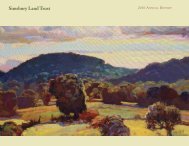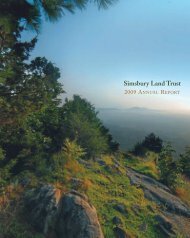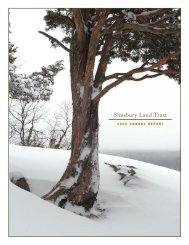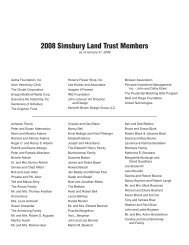The Walkbook - Simsbury Land Trust
The Walkbook - Simsbury Land Trust
The Walkbook - Simsbury Land Trust
You also want an ePaper? Increase the reach of your titles
YUMPU automatically turns print PDFs into web optimized ePapers that Google loves.
36<br />
SAND PLAIN FORESTS<br />
Several sizable and more or less contiguous Town, State, and<br />
private lands in the central part of town provide a variety of walking<br />
opportunities in a sand plain forest setting. <strong>The</strong> walks are relatively<br />
flat with some modest knolls, and include Great Pond State Forest,<br />
Stratton Brook State Park, Still Brook Open Space, Town Open Space<br />
at the southwest corner of Bushy Hill and Stratton Brook roads,<br />
Ethel Walker School, and Belden Forest.<br />
Sand plain forests are home to a rich variety of birds and<br />
animals that prefer this environment to wetlands or nearby hills for<br />
foraging and raising their young. <strong>The</strong> forests are characterized by<br />
thick layers of sand and gravel under topsoil. <strong>The</strong> soil, deposited by<br />
retreating glaciers, tends to be well drained and can become quite<br />
dry in places. This creates variations in the patterns of vegetation<br />
relative to the nearby ridges and wetlands. Influences such as fire in<br />
pre-colonial days, followed later by logging, plowing, and pasturing,<br />
have profoundly shaped present sand plain vegetation. For example,<br />
nonpalatable plant species such as cedar and juniper, able to thrive<br />
under heavy grazing conditions, have relatively recently been forced<br />
into decline under the canopy of oak, maple, hickory, and black<br />
cherry. Fire sensitive conifers are the most recent large trees to join<br />
the canopy.<br />
NOTES<br />
37







